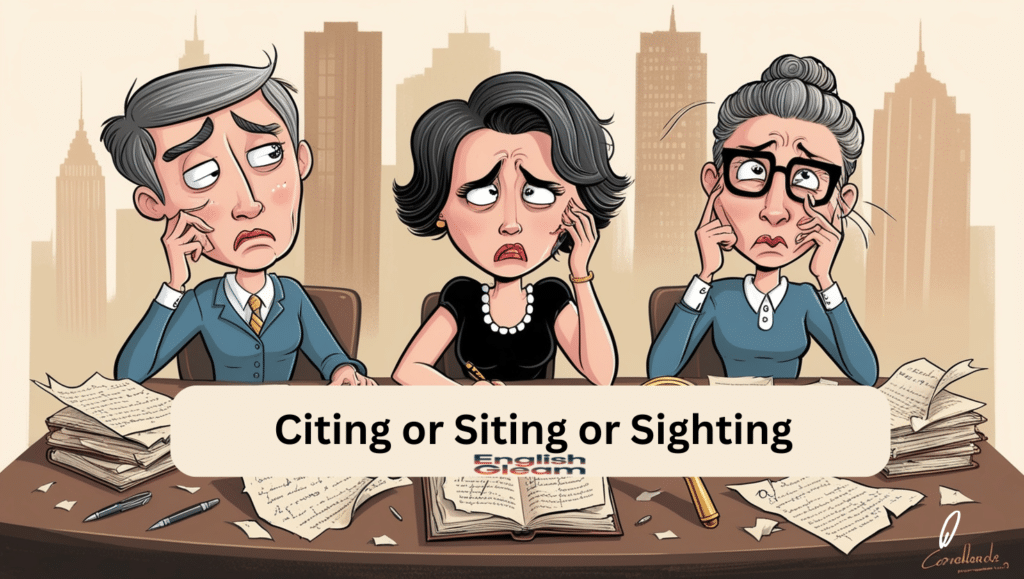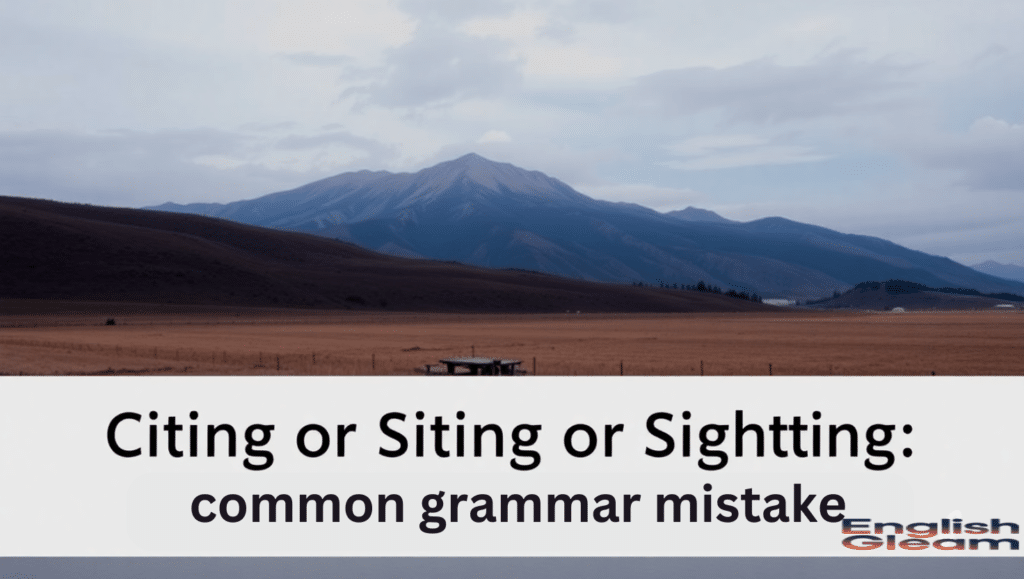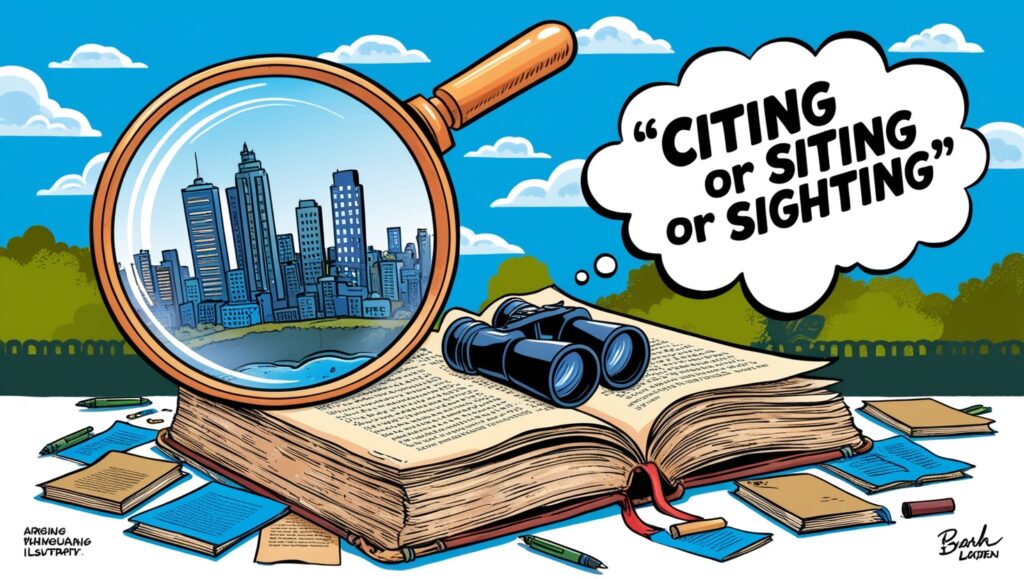The English language can be tricky, especially when words sound the same but have entirely different meanings and uses. Among the most common confusions are the words “citing,” “siting,” and “sighting.” These three homophones often lead to mistakes in both writing and speaking, even among experienced users of the language. Understanding the distinctions between them is not only important for avoiding embarrassing errors but also for ensuring clarity in both professional and academic contexts. In this article, we will explore the difference between these three terms, provide examples of their correct usage, and offer tips to avoid common mistakes.
Understanding the Difference: Citing, Siting and Sighting
Although “citing,” “siting,” and “sighting” all sound similar, they each have specific definitions and uses. It’s important to grasp these distinctions, as using the wrong one could completely alter the meaning of your sentence. Let’s break them down.
Citing: Referring to Sources
“Citing” refers to the practice of referring to sources of information, especially in academic or professional contexts. This is a critical part of academic writing, journalism, and legal documents, where you need to acknowledge the original source of ideas, facts, or quotes. In most formal settings, failure to cite sources properly can lead to accusations of plagiarism, which is a serious offense in academic and professional fields.
Also read : 25 formal synonyms for “just to confirm”
The primary function of citing is to give credit to the original author or creator and to allow your audience to locate the source if they want to explore it further. Citation is typically done using specific formats such as APA (American Psychological Association), MLA (Modern Language Association), or Chicago style, each of which has its own rules for how references should be formatted.
Examples of citing in sentences:
- “The researcher cited several studies to support her hypothesis on climate change.”
- “In the article, the author cited an influential paper from 2008.”
- “When citing legal precedents, it’s essential to follow the correct citation guidelines to maintain legal accuracy.”
As seen in these examples, “citing” is used when referencing or quoting a source. Whether you’re writing a research paper or creating a news article, proper citation ensures that you’re upholding academic integrity and professional standards.
Siting: Referring to Location or Placement
“Siting,” on the other hand, is related to the act of choosing or planning the location or placement of something. This term is often used in the fields of architecture, urban planning, construction, and real estate development. It’s about determining where something should be situated based on a variety of factors such as geographical considerations, environmental impact, or logistical requirements.
The most common use of “siting” occurs in discussions of building locations or the placement of infrastructure. For instance, when an architect is tasked with designing a new building, they need to carefully consider where the building will be situated—this process is called “siting.” In other words, “siting” refers to the decision-making process about where to place something rather than where it has already been placed.
Examples of siting in sentences:
- “The construction team is siting the new library near the university to maximize accessibility for students.”
- “The architect had to consider environmental factors when siting the new office complex.”
- “The city council approved the siting of a new park in the downtown area.”
As shown, “siting” is used to describe the decision or process of selecting a location for a project or structure. It is crucial in areas like urban planning and construction, where the choice of site can have significant implications on the project’s success or failure.

Sighting: Referring to the Act of Seeing
“Sighting” deals with the act of seeing or observing something, often something rare or noteworthy. It’s commonly used in contexts like wildlife watching, astronomy, and even paranormal activities. When someone reports a “sighting,” they are typically sharing that they have seen something unusual, exciting, or otherwise significant.
The term “sighting” is most frequently used when referring to rare or significant visual occurrences. For example, a “sighting” of a rare animal could mean someone has spotted an endangered species. Similarly, a “sighting” of a UFO might be someone claiming to have seen an unidentified flying object.
You might also like : 25 Ways to Say “Looking Forward to Seeing You” Professionally
Examples of sighting in sentences:
- “The hiker had an exciting sighting of a bear while trekking through the forest.”
- “Astronomers reported several sightings of the comet during its flyby of Earth.”
- “There were numerous sightings of strange lights in the sky last night, leading some to believe in extraterrestrial activity.”
“Sighting” focuses on the act of seeing or observing something, particularly when it’s of special interest. Whether it’s a rare animal, an unusual event, or a notable occurrence, “sighting” refers to the experience of noticing or spotting something noteworthy.
Common Grammar Mistakes and How to Avoid Them
Now that we’ve explored the definitions of “citing,” “siting,” and “sighting,” it’s time to discuss how to avoid common mistakes. Misusing these terms can confuse your readers, especially in professional, academic, or legal contexts. Let’s look at some common errors and how to fix them.
Confusing “Citing” and “Siting”
One of the most common mistakes is confusing “citing” with “siting.” Since both words can appear in academic or professional contexts, mixing them up can lead to serious confusion. For example:
- Incorrect: “The professor emphasized the importance of siting your sources correctly in the research paper.”
- Correct: “The professor emphasized the importance of citing your sources correctly in the research paper.”
In the incorrect example, “siting” is used, but the intended meaning is about referencing sources, which is clearly a matter of “citing.” To remember this, think about the connection between citation styles like APA and MLA and the word “cite.” If you are referencing something, you’re citing it, not siting it.
Confusing “Citing” and “Sighting”
Another common mistake is confusing “citing” with “sighting,” particularly when writing about research or reporting. For instance:
- Incorrect: “The study provides a sighting of multiple sources on climate change.”
- Correct: “The study provides a citing of multiple sources on climate change.”
In this example, the word “sighting” is incorrect because the sentence is discussing referencing sources, not observing something. The correct word here is “citing,” referring to the acknowledgment of sources in research or academic writing.
Also read it : 20 Ways to Say “Clean Up After Yourself” Professionally
Confusing “Siting” and “Sighting”
Finally, some people mix up “siting” and “sighting,” especially when discussing events or observations in scientific or nature-related contexts. For example:
- Incorrect: “The team is siting a rare bird species during their field study.”
- Correct: “The team is sighting a rare bird species during their field study.”
Here, “siting” is incorrect because the sentence is about the act of observing or seeing something rare, in which case the correct term is “sighting.”

How to Remember the Differences
Given the similarity in pronunciation, it can be challenging to keep these words straight. Here are a few tips to help you remember their meanings and uses:
- Cite sounds like “reference.” When you’re referring to a source in academic work, think of citation styles like APA and MLA.
- Site sounds like “location.” Whenever you’re talking about where something is placed or planned, such as a building or construction project, you’re talking about siting.
- Sight sounds like “see.” This one is easy to remember because it deals with what you observe, especially rare events or sightings.
Practical Examples to Clarify Usage
To further cement your understanding, here are some practical examples of how each word is used in different contexts:
- Citing:
- “The author did not properly cite his sources, leading to accusations of plagiarism.”
- “Make sure you are citing your references according to the correct citation style.”
- Siting:
- “The architect was responsible for siting the new school in an area that would be safe for students.”
- “The engineers are siting the new wind farm in an area with consistent wind patterns.”
- Sighting:
- “The wildlife conservation group has been tracking the sightings of endangered species in the region.”
- “There were multiple sightings of a rare bird species in the park this spring.”
Must read : 25 Ways to Say “I Appreciate Your Help” Professionally
Conclusion:
In conclusion, understanding the differences between “Citing,” “Siting,” and “Sighting” is essential for avoiding common grammar mistakes. Each word has its own unique meaning, and using them correctly will make your writing clearer and more professional.
By remembering the distinctions between these homophones, you can improve your writing skills and communicate more effectively. Whether you’re citing sources, choosing a site, or describing a sight, knowing the correct word for the context ensures accuracy and prevents confusion.

William Jams is an experienced blogger at EnglishGleam, passionate about language, writing, and storytelling. With years of expertise in crafting engaging content, she aims to inspire readers through insightful articles that enhance their English skills and knowledge.








I like what you guys are up too. Such clever work and reporting! Carry on the superb works guys I¦ve incorporated you guys to my blogroll. I think it’ll improve the value of my website 🙂
I have been browsing online more than three hours today, yet I never found any interesting article like yours. It’s pretty worth enough for me. Personally, if all website owners and bloggers made good content as you did, the internet will be much more useful than ever before.
thanks Brother
I think the admin of this web site is genuinely working hard
for his web page, since here every material is quality based stuff.
I know this if off topic but I’m looking into starting my own weblog and was curious what all is needed to get set up? I’m assuming having a blog like yours would cost a pretty penny? I’m not very web savvy so I’m not 100 certain. Any recommendations or advice would be greatly appreciated. Thank you
Nice weblog right here! Also your site lots up very fast! What web host are you using? Can I get your affiliate hyperlink on your host? I want my website loaded up as fast as yours lol